Comprehensive Guide to Full Build Skateboards


Intro
Skateboarding is more than just a sport; it’s a way of life, an art form, and a unique culture that has evolved over decades. At its core, a full build skateboard is the backbone of this exhilarating pastime. From cruising down city streets to nailing tricks at a local skate park, the components of each skateboard play a crucial role in performance and personal expression. This guide takes a closer look at everything that goes into creating a solid skateboard, including the essentials like deck design, truck selection, wheel options, and the often-overlooked aspect of bearings.
For skaters—whether you’re a fresh-faced beginner or someone who’s been grinding for years—understanding your board can save you time, money, and frustration. Knowing how to put together a skateboard that suits your style and preferences not only enhances your riding experience but also allows you to grasp the broader cultural significance of skateboarding within the surfboarding community.
Let’s delve into the nitty-gritty of full build skateboards, exploring assembly techniques and customization options that can turn a simple board into a true reflection of who you are as a skater.
Understanding Full Build Skateboards
Skateboarding is not just a sport; it’s a culture and a way of life for many. Understanding full build skateboards is essential for anyone looking to truly engage with this vibrant activity. A full build skateboard, as the name suggests, consists of all necessary components to create a personalized skating experience. It’s like piecing together a jigsaw puzzle, where each element plays a vital role in determining performance, style, and comfort.
When one invests time and effort in a full build skateboard, it offers a multitude of advantages. For starters, crafting your own setup ensures that the skateboard aligns with your unique style, whether you prefer cruising, tricks, or downhill riding. This level of customization allows for an optimized performance based on individual preferences—making it an essential aspect for both new riders and seasoned pros alike.
Moreover, understanding these skateboards allows one to appreciate the intricate balance of design and function. Factors such as deck angle, wheel hardness, and truck width all combine to offer different riding experiences. Skaters need to consider how each piece influences the overall performance based on their skating habits and the terrain they’ll be navigating.
In addition to performance, there’s a sense of connection and personal expression that comes with building your skateboard. Each piece can reflect one’s personality or artistic inclinations, from deck graphics to wheel colors. All these components together create not just a board, but a canvas that resonates with the skater’s identity.
Ultimately, grasping the intricacies of full build skateboards empowers skaters to elevate their sport to new heights, which is what we’ll explore in this guide. Let’s move deeper into its definition and how this movement found its roots in history.
Definition and Overview
A full build skateboard refers to a complete setup that includes all the essential components required for riding. Rather than buying a pre-assembled board off the shelf, some enthusiasts opt for a full build to curate their perfect skate experience. A typical full build is made up of several vital parts:
- Deck: The flat board where the skater stands. Decks vary in length, width, and materials.
- Trucks: The metal T-shaped components that attach the wheels to the deck. They affect how loose or tight the ride feels.
- Wheels: These come in various sizes and durometers—hardness levels—which determine the feel and grip during rides.
- Bearings: These sit inside the wheels, allowing them to spin smoothly and efficiently.
By selecting each of these pieces, skaters can customize their boards to suit different styles, terrains, and personal preferences. Thus, the concept of full build skateboards transcends mere assembly; it embraces customization, making skateboarding more than just an activity.
Historical Context
Skateboarding has a rich tapestry woven from various influences, beginning in the late 1940s when surfers sought to bring their beloved ocean sport to the streets. The earliest skateboards were simple wooden planks with roller skate wheels attached to the bottom, not much different from a kitchen table on wheels.
As tricks became popular in the ’70s and ’80s, the designs evolved significantly. The introduction of the wooden deck made from plywood allowed for better durability and a wider variety of shapes. Notably, the fun shapes and vibrant graphics began to emerge, allowing skaters to showcase their personalities. Major brands like Powell Peralta and Santa Cruz were born, pushing the limits of design.
The DIY culture gained momentum in the ‘90s, fueled by the rise of skate parks and street skating. Skaters began to experiment with swapping parts, leading to the concept of customizing individual components. This paved the way for the full build skateboard concept we see today, where skaters piece together their dream setups based on specific performance needs.
As the culture grew, so did the awareness around different skating styles—street, vert, freestyle, and cruising—each with its own unique demands on skateboard design and setup.
Through this historical lens, we see how full build skateboards emerged from humble beginnings into a dynamic industry tailored to individual needs, emphasizing performance, style, and cultural identity.
Components of a Full Build Skateboard
Building your own skateboard is like crafting a unique tune; every component influences the ride, feel, and overall experience. Understanding these key parts will not only enhance your skills but also let you tailor the board to your style. Each piece plays a crucial role — let’s unpack what’s underneath.
The Deck
Material Types
Choosing the right material for your skateboard deck affects not just durability but also the overall ride experience. Common materials include maple, bamboo, and fiberglass.
- Maple: This wood is a longtime favorite, giving boards a robust structure. It’s popular for its resilient qualities and generally good flexibility, making it suitable for various riding styles.
- Bamboo: This material adds a touch of lightness, making the board feel nimble. Its flexibility is appreciated by those who prefer tricks and softer landings.
- Fiberglass: Known for its strength, fiberglass allows for thinner designs while retaining durability. It's often combined with wood layers for a balanced performance.
Each material has its own distinct vibe, and what suits one rider may not suit another, so choosing wisely is key to a satisfying skate experience.
Shape and Size Options
The shape you select for your skateboard deck can transform your riding. From popsicle shapes perfect for street skating to wider cruiser decks for relaxed rides, there's a fit for everyone.
- Popsicle: The classic shape for tricks, this board is symmetrical; it gives versatility for both street and park skating.
- Cruiser: Wider and often with a kicktail, cruiser boards are laid-back, designed for smooth rides and getting from one place to another comfortably.
- Longboard: Longer than traditional boards, these are great for downhill rides or cruising, offering stability that many skaters crave.
Sizes typically run between 7.5" to 9" wide. Wider boards generally facilitate better balance while narrower boards permit easier trick execution.
Graphic Design
Graphics aren’t just for show; they represent personality and culture in skateboarding. A well-designed graphic can make a statement, be it bold or subtle. Most decks showcase vibrant art or brand logos that resonate with different communities.
- High-quality Screen Prints: These are durable and maintain vibrancy even after hitting the pavement repeatedly.
- Custom Designs: Some riders opt for personalized graphics, adding a unique flair that reflects their style or inspirations.
While aesthetics may seem superficial, a striking graphic can bolster pride and connection to the skateboarding culture.
Trucks
Importance of Truck Width
Truck width has a significant influence on stability and trick performance. When paired correctly with the deck size, it optimizes the balance and maneuverability of the board.
- Narrow Trucks work well for street skaters, as they allow for tighter turns and tricks in tight spaces.
- Wider Trucks give better stability, making them a wiser choice for larger riders or those who enjoy cruising.
Matching your truck width to your deck width is critical. Misalignment can lead to difficulties in controlling your ride.
Baseplate and Hanger Design
The baseplate and hanger essentially dictate how the board responds under pressure. A higher-quality baseplate can make all the difference when landing jumps or navigating hard turns.
- Low-profile baseplates allow for quicker response times during maneuvering, while high baseplates might enhance leverage in flips.
- Hanger designs vary in shape, which influences how quickly the board can pivot. A well-fitted hanger improves grind quality and overall stability.
These components should be selected thoughtfully to create a harmonious ride.
Bushings and Hardware
Bushings are the unsung heroes of skateboard trucks. They are the rubber-like components that provide the spring necessary to absorb shock and maintain balance.
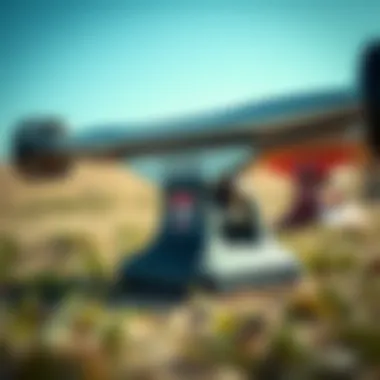
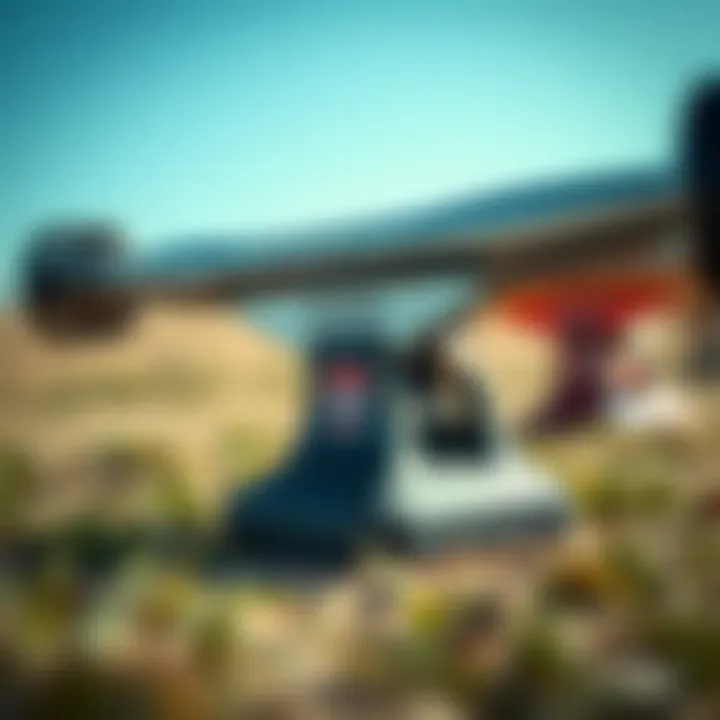
- Soft Bushings cater to beginners or those who favor easy turns.
- Firm Bushings benefit more aggressive riders who demand control during sharp maneuvering.
Selecting the right bushings and hardware can make or break your skating experience, giving you either a smooth ride or a rough one depending on your choice.
Wheels
Durometer and Hardness
The hardness of wheels affects grip and performance. The durometer scale measures wheel hardness, ranging from soft (78A) to hard (101A).
- Soft Wheels (78A - 87A) are great for cruising due to their ability to coalesce with rough surfaces. They can absorb bumps well, ensuring a smoother ride in urban environments.
- Hard Wheels (88A - 101A) enhance speed and slide capability, preferred by tricksters looking for that extra edge in performance.
Choosing the right hardness directly relates to where you’ll be skating the most.
Shape Variations
Wheel shape affects how they disperse weight and how they perform.
- Square-edged wheels lend themselves to power tricks and slides, whereas round-edged wheels naturally provide easier maneuvering.
- Wider wheels offer more stability while narrower options quicken transition and rotation.
Ultimately, selecting the shape contributes significantly to personal skating style.
Wheel Diameter Considerations
Wheel diameter varies, generally falling between 50mm to 60mm.
- Smaller Wheels (50mm - 55mm) are ideal for tricks but might feel sluggish on rough terrain.
- Larger Wheels (56mm - 60mm) offer better speed and smooth transitions but can compromise maneuverability depending on the tricks attempted.
Customize based on your style and skating location to get the most out of your set-up.
Bearings
ABEC Ratings
ABEC ratings serve as a simple way to estimate the quality of bearings. The scale goes from 1 to 9, with higher numbers implying smoother and faster rides.
- Higher-rated bearings often come with better precision and less friction during motion, making them essential for the speed enthusiasts.
- However, they are also pricier, meaning less flashy skaters might opt for more affordable options with lower ratings, focusing on durability instead.
Recognize that a higher ABEC does not automatically guarantee a superior experience for every rider, as riding style plays a big role too.
Material Considerations
Bearings come in various materials, mainly metal or ceramic.
- Metal Bearings are durable and reliable. They are typically more affordable but can wear out faster under heavy usage.
- Ceramic Bearings reduce friction even further, providing an ultra-smooth ride but can break the bank.
Choosing recognized materials impacts how often you’ll need replacements and how your board will feel in the long run.
Maintenance Tips
Taking care of your bearings is crucial to extend their lifespan. Basic maintenance includes cleaning, lubricating, and regular checks.
- Regular Cleaning of debris and dirt ensures the bearings don’t seize up.
- Proper Lubrication can reduce friction, enhancing speed and efficiency.
Adhering to these maintenance tips will keep your board rolling smoothly, so get into the habit of routine care for optimal performance.
Assembling Your Full Build Skateboard
Assembling your skateboard from scratch can be an exciting and rewarding endeavor. It allows you to create a setup that fits your unique riding style while ensuring the quality of each component. This section focuses on the essential aspects of assembling a full build skateboard, emphasizing the significance of proper tools and technique in achieving a smooth ride.
Choosing the Right Tools
Before diving into the assembly process, having the right tools on hand makes all the difference. Using the appropriate tools not only speeds up the construction process, but also ensures each component is secured correctly. Essential tools include:
- Skateboard wrench: This is specifically designed for tightening nuts on your trucks and wheels.
- Screwdriver: Needed especially for securing the grip tape or any additional accessories.
- Utility knife: For cutting grip tape and any other necessary adjustments.
- Ruler or measuring tape: Useful for ensuring precise measurements, particularly when customizing distances between trucks and wheels.
Having these tools within arm’s reach will help prevent getting sidetracked, keeping your focus and efficiency high.
Step-by-Step Assembly Guide
Installing Trucks
Trucks are one of the most crucial components of your skateboard, influencing how it handles turns and maintains stability. Installing them correctly guarantees you have a dependable setup. First, ensure the truck's kingpin aligns with the holes on the deck. A key characteristic of truck installation is the proper tightness; they must not be too loose, or else your ride can become unsafe. Tighten using the skateboard wrench until snug.
The unique feature of installing trucks is the pivot cup, which plays a pivotal role in your board’s turn radius. A well-installed truck allows for seamless turning, helping you navigate curves with ease. However, overly tight trucks can restrict maneuverability and lead to an uncomfortable ride. It's a balancing act that can take some fine-tuning.
Attaching Wheels
Wheels play a vital role in how your board interacts with the ground. When attaching wheels, ensure the spacers are positioned correctly within the trucks. Key characteristics of wheels include their diameter and hardness, which directly affect the overall feel of your ride. The proper selection can enhance speed, control, and grip.
The beauty of attaching wheels yourself is the option to mix and match. You might prefer softer wheels for a smooth ride on rough surfaces or harder wheels for enhanced speed on smooth skateparks. However, choosing the wrong type—like soft wheels on a smoother surface—can lead to decreased performance and unwanted slowing down.
Lubricating Bearings
Bearings are often overlooked but provide the frictionless rotation of your wheels, allowing for a smooth ride. Proper lubrication is critical. It helps to reduce friction and wear over time, ultimately extending the life of the bearings. The key characteristic of bearing maintenance is ensuring it's neither too over-lubricated nor too dry, as both extremes can lead to performance issues.
When applying lubricant, use a high-quality bearing oil. The unique aspect of this maintenance step is that it requires periodic checks. Regular lubrication every couple of weeks—more often if skating frequently—will keep your ride smooth. Neglecting them can lead to unnecessary drag and impaired speed, especially when you're looking to pick up some pace on your board.
Keeping your skateboard in top shape through the assembly process and proper maintenance ultimately ensures a better riding experience.
Customization Options
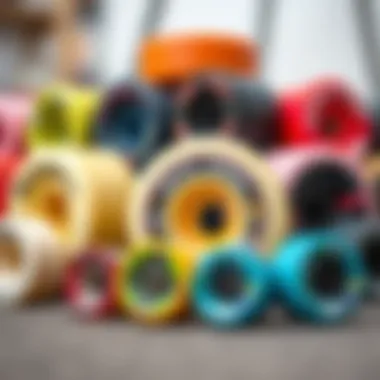
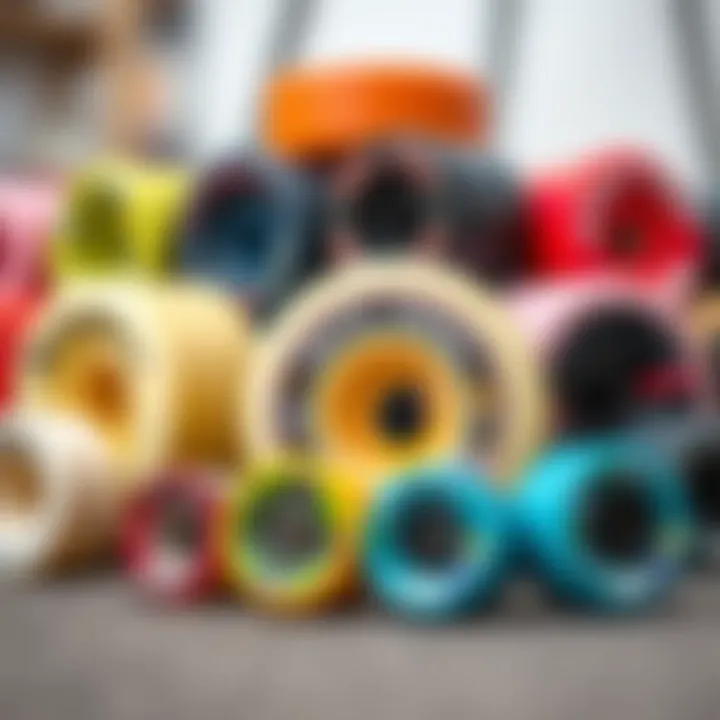
Customization options play a pivotal role in the full build skateboard scene, appealing to both novice and experienced riders alike. The ability to tailor a skateboard setup allows individuals to express their unique style and preferences, which goes beyond simply looking cool. Personalizing components can enhance performance, comfort, and enjoyment, making the ride more attuned to one’s skating style. Overall, the possibilities are nearly endless, allowing for a highly individualized experience while pushing the boundaries of creativity.
Tailoring Your Skateboard Setup
Deck Customization
Deck customization is one of the most significant aspects of personalizing a skateboard. The deck is the foundation of any skateboard, and it influences the feel and control a rider has while skating. A rider might choose a particular graphic, shape, or even the material that resonates with their style or skating technique. For instance, a wider deck could provide better stability for a street skater, while a slimmer deck might suffice for a trick-focused rider.
The key characteristic of deck customization is its versatility. Custom decks can be made from various materials like maple, bamboo, or fiberglass, each offering different flexibilities and durability. A unique feature of deck customization is its ability to incorporate personal designs, symbols, or artwork, allowing for an expressive statement about the rider’s personality.
While appealing, deck customization comes with its own set of advantages and disadvantages. Custom decks can be more expensive and take longer to receive than mass-produced options; however, they offer a tailored experience that pre-made decks cannot match. Whether it’s for performance or aesthetics, customizing your deck is a defining feature of a full build skateboard.
Truck Adjustments
Truck adjustments are all about fine-tuning how the skateboard handles. The truck width, height, and angle can dictate stability, turning radius, and how high a rider can ollie.
The main advantage of adjusting your trucks is the ability to create a ride that feels tailored to individual preferences. For example, a rider looking to cruise might prefer wider trucks for added stability, while someone concentrating on performing tricks may lean toward narrower options to enhance maneuverability.
An intriguing aspect of truck adjustments is the use of riser pads, which can elevate the trucks, providing extra clearance for larger wheels and preventing wheel bite. This adjustment helps to optimize the overall performance of the skateboard, but it can potentially feel different from a lower setup depending on personal preference.
However, adjusting trucks might come with some drawbacks. If not done correctly, it can lead to a precarious balance that negatively impacts performance and safety. So, riders must experiment judiciously to find what works best for them.
Wheel Selection
Selecting the right wheels is crucial to the skating experience, as wheels vary significantly in terms of hardness, shape, and diameter.
One key characteristic of wheel selection is the durometer rating, which indicates how hard or soft the wheel is. Softer wheels, typically with a durometer of 78A to 87A, provide better grip and shock absorption, making them ideal for rough terrains like skateparks or streets. In contrast, harder wheels, usually from 88A and above, allow for higher speeds and slide more easily, making them popular for street skating.
A unique feature in wheel selection involves various shapes and sizes. Wider wheels offer more traction and stability, while smaller wheels may enable quicker turns and are lighter, providing agility.
The benefits of careful wheel selection are evident in the riding experience; however, these choices come with their own set of cons. An unsuitable choice might hinder the ride, making it sluggish or difficult to control. Riders must carefully consider their skating style and the surfaces they favor to choose the best wheels for their setup.
Aesthetics and Graphics
Custom Paint Jobs
Custom paint jobs on skateboards allow riders not only to make a fashion statement but also to take complete ownership of their setup. A stunning paint job can transform a standard deck into an eye-catching piece of art.
The main feature of custom paint jobs is that they often reflect the rider's personality. Whether it showcases intricate designs, vibrant colors, or unique motifs, it sets the tone for individual expression. A standout advantage is the notable differentiation from mass-produced boards, showcasing creativity and artistry that can inspire admiration from peers.
However, applying custom paint can have drawbacks. Depending on the materials and methods used, some paint jobs might not stand the test of time, fading with wear or exposure to elements. Furthermore, it can be costly and may require specific skills to achieve a desired effect.
Stickers and Grip Tape
Stickers and grip tape are often overlooked but are effective ways to personalize a skateboard. Stickers can be used to showcase interests, affiliations, or even just express humor. On the other hand, grip tape influences performance as it offers traction between the skateboarder’s feet and the board, which is essential for control.
The key characteristic of stickers and grip tape customization is simplicity combined with ease of expression. Riders can strategically place stickers on their boards to add a touch of flair, while the grip tape can be customized not just for aesthetics but also for texture preferences.
The advantages are clear—both options are affordable and easy to change. However, they also bring potential downsides; poorly applied stickers can peel off, while grip tape may wear down or lose texture over time, requiring replacements. In sum, these elements allow for quick adaptations and changes that reflect one's style without deep financial investment.
Customizing your skateboard isn’t just about functional performance; it’s a vehicle for personal expression and reflection of your identity as a rider. The blend of aesthetics and practicality can give a whole new life to your ride.
Skateboard Maintenance
Maintaining your skateboard is an essential part of being a responsible skater. Just as a surfer wouldn’t ride a board with dings, a skateboarder needs to ensure their gear is in tip-top shape. Regular maintenance can prevent accidents, enhance performance, and prolong the lifespan of the components. Ignoring routine checks could lead to more significant issues down the line and can even hamper your skateboarding experience.
Routine Care
Cleaning Wheels
Cleaning wheels might not be the first thing on every skater’s mind, but it’s crucial for smooth rides. Dust, dirt, and grime can cause wheels to lose grip over time. Regular cleaning ensures optimal performance.
One effective way to tackle this task is to remove the wheels and use warm water mixed with mild soap. A soft brush can help scrub off the toughest dirt. Keeping your wheels clean minimizes the risk of slipping and improves your overall control. Not to mention, it’s rather satisfying to see your wheels shine again!
Key Characteristic: Regular cleaning has a noticeable effect. A clean wheel maintains grip and performance.
Advantages: Improved traction, reduced wear, and a longer lifespan of the wheels.
Disadvantages: It might take a bit of time and effort, but the end result is worth it.
Checking Hardware Tightness
Another vital aspect of skateboard maintenance is ensuring all hardware is tight. Loose nuts, bolts, and screws can lead to disastrous falls or impair performance. A fast and effective way to check tightness is simply using a skate tool.
Regular checks can keep your setup reliable and safe. It’s best to do this routine inspection after a skating session or at least once a week, especially if you skated hard. Over time, bumps and impacts can loosen hardware, and trusting that it’s tight without checking is like driving a car with questionable brakes.
Key Characteristic: Provides safety and stability during rides.
Advantages: Peace of mind and mitigated risk of falls.
Disadvantages: Neglect can lead to severe issues, yet it takes just a moment to check.
Inspecting the Deck
Your skateboard deck carries the most weight, both literally and figuratively. Inspecting the deck regularly can uncover cracks or bends that could compromise its strength. It’s important to look for any chips or damages that might have occurred due to hard impacts.
A well-maintained deck translates to better control and balance while skating. Periodic checks can also alert you to replace a damaged deck before it becomes hazardous.
Key Characteristic: Ensures optimal performance and safety.
Advantages: A sound deck means better tricks and smoother rides.
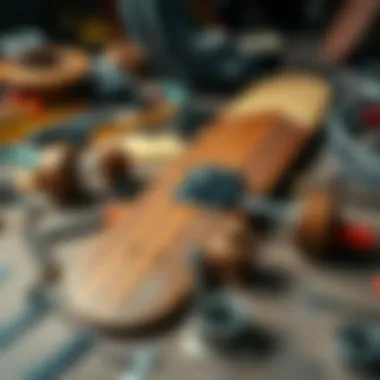
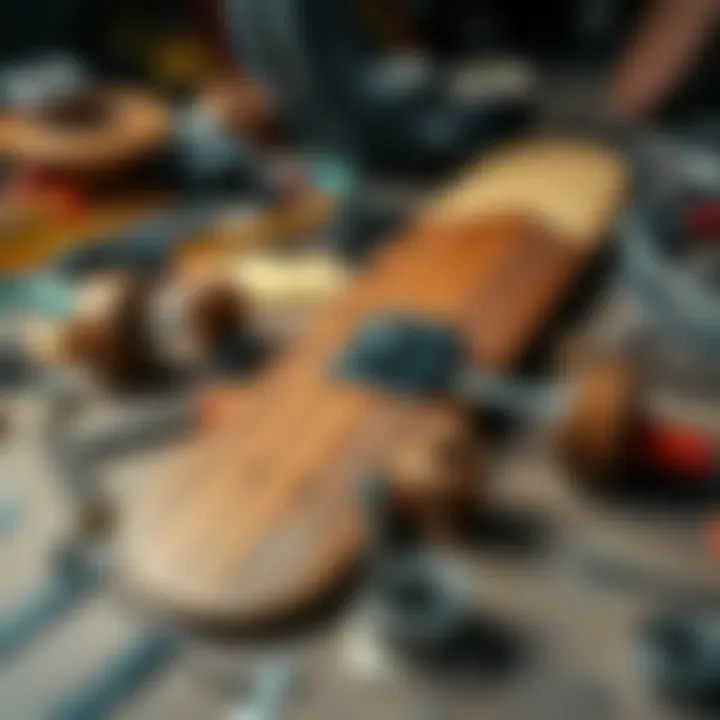
Disadvantages: Waiting too long to inspect may lead you to skate with a damaged deck, which could be dangerous.
When to Replace Components
Knowing when to replace your skateboard components is just as important as maintaining them. Skaters who recognize the signs of wear and other indicators will have a safer, more enjoyable ride.
Signs of Wear
Skateboards, like any equipment, degrade over time. Watch out for visual cues, such as cracks or excessive wear on the wheels. If your tricks don't feel the same or if you notice unexpected responses from your skateboard, it might be time for a new deck or wheels.
Key Characteristic: Timely replacements can prevent injuries.
Advantages: Better performance and less hassle in the long run.
Disadvantages: It may require spending money if it’s not visually apparent when something needs replacing.
Performance Indicators
Performance indicators can act as helpful signals for when to change out components. If you find your skateboard is harder to control, slower to respond, or if you're hearing odd noises during tricks, these could be signs that internal components are failing.
Key Characteristic: Monitoring these indicators can greatly improve your skating experience.
Advantages: Quicker replacements can improve safety and enhance your overall performance.
Disadvantages: Replacement costs can add up, so being cautious and discerning is key.
By keeping a routine check on your skateboard and understanding when parts need replacing, you maintain a reliable setup that’s always ready for action. Just remember, an ounce of prevention is worth a pound of cure, as they say.
Exploring Skateboarding Communities
The importance of skateboarding communities cannot be overstated when discussing the full build skateboard. These communities represent an ecosystem where creativity, camaraderie, and skill development flourish. Finding connection through shared passions allows skate enthusiasts to learn, trade tips, and offer support toward their growth as skaters. Moreover, community engagement often translates to a deeper appreciation for skateboarding as more than just a sport; it becomes a lifestyle and a form of artistic expression.
Local Skateparks and Hangouts
Local skateparks serve as the heart of skateboarding communities. These parks are buzzing with activity—there’s the unmistakable sound of wheels on concrete, the laughter of friends, and the occasional cheer when someone lands a tricky trick. Skateparks are more than just venues for practicing; they are hubs of social interaction. Meeting fellow skaters at these local spots fosters an atmosphere of friendship and mutual encouragement, which is vital for a skateboarder’s journey.
Benefits of Local Skateparks:
- Skill Development: Using ramps and rails, skaters can work on specific tricks that will improve their overall skill set.
- Networking Opportunities: It's an ideal place to meet local skateboarders, exchange knowledge, and even form alliances for group rides.
- Community Events: Many skateparks host contests or community events, creating opportunities for local talent to shine.
It’s not unusual to see seasoned skaters helping beginners out; these acts of kindness cultivate an inclusive environment that encourages new skaters to keep trying. Furthermore, hangouts near skateparks often bring skaters together, whether it’s grabbing a slice of pizza post-session or just chilling at a nearby spot enjoying the company of others who share their passion.
Online Forums and Groups
In today’s digital age, online forums and groups have emerged as invaluable resources within the skateboarding community. Platforms such as Reddit or specialized skateboarding forums allow skaters to connect across geographical boundaries. Here, discussions range from technical advice on board setups to philosophical debates about skate culture.
Engaging in these online spaces can offer:
- Global Perspective: Skaters can interact with fellow enthusiasts worldwide, broadening their insight into techniques and styles different from their own.
- Access to Diverse Content: Users share videos, articles, and tutorials, allowing others to learn at their own pace without the pressure of real-time practice.
- Support Networks: Many find comfort in connecting with others who share similar experiences and challenges while skating.
For anyone looking to bolster their knowledge about skateboards, these online communities are gold mines. They facilitate learning and provide motivation through new perspectives on skating while connecting old and new generations of skateboarders.
"Skateboarding connects people across different cultures, breaking down barriers and nurturing friendships that last a lifetime."
Discovering local skateparks and thriving on online forums enriches the skateboarding experience, blending personal growth with a sense of community.
Joining local and online skateboarding communities is not merely about mastering tricks on a board; it's a way to immerse oneself in a lifestyle enriched by support, inspiration, and shared passion.
The Cultural Impact of Skateboarding
Skateboarding isn’t just a sport; it’s a movement that transcends mere physical activity. Over the decades, it’s festooned itself with layers of culture, lifestyle choices, artistic expressions, and even its own language. Its rhythmic wheels against pavement tell stories that intertwine community, societal change, and artistic growth. Understanding its cultural dimensions enriches the skateboarding experience, making it more than just a casual pastime. In this section, we’ll explore how skateboarding influences and reflects culture, as well as the personal expression it encourages.
Skateboarding and Artistic Expression
From the first carved wooden boards to today’s high-tech creations, skateboards have been viewed as canvases for self-expression. Many riders have turned their boards into colorful masterpieces, combining custom paint jobs and unique graphics to showcase their individuality. This artistic flair isn't limited to just the boards themselves; it also resonates deeply in the creation of skate parks, where urban art forms like graffiti breathe life into cold concrete.
Moreover, skateboard culture has inspired various art forms, including photography and film. Consider the documentaries and films that capture the essence of skateboarding—each telling the stories of creativity and rebellion against the norm. A great example is Dogtown and Z-Boys, which documents the rise of skateboarding as a sport and its roots in surf culture, presenting skateboarding not just as a sport but a lifestyle choice.
Art doesn’t just stop at visual mediums in skateboarding. Music has also played a pivotal role, influencing and being influenced by skate culture. Punk rock, hip-hop, and even electronic genres have developed symbiotic relationships with the skateboarding community, with many bands embracing the skateboard lifestyle and vice versa.
"Skateboarding is a cultural revolution. It’s about unity, diversity, and freedom of expression."
This cliche-free idea carries weight. It’s not just about the tricks or how high you can ollie; it’s about a collective ethos—a desire to redefine boundaries, both on the board and in life.
Influence on Fashion and Lifestyle
Skateboarding has profoundly shaped fashion and lifestyles, going beyond mere function. The baggy pants, graphic tees, and oversized sneakers that have become synonymous with skate culture reflect a rebellion against mainstream fashion norms. Skate brands like Supreme, Vans, and Thrasher have mainstreamed, blurring the lines between skate lifestyle and high fashion. Wearing these brands often resonates with a deeper connection to the skate community, aligning the consumer with an ethos of creativity, freedom, and rebellion.
Clothing isn't just for flair; it’s often designed with functionality in mind. Whether it's reinforced seams to withstand wear and tear or breathable fabrics to keep comfortable, skate apparel addresses the physical demands of the sport while making a statement.
Furthermore, skateboarding influences lifestyle choices that extend beyond what to wear. The culture encourages a sense of community and friendship among those who ride. From backyard ramps to urban skate spots, the skateboarder ethos often emphasizes camaraderie and support, fostering social networks among diverse groups. Events like skate competitions also serve as melting pots of culture, where individuals from all walks come together, unified by their love for skating.
The impact of skateboarding on lifestyle is multifaceted. Skate parks can be seen as community hubs that encourage social interaction, promote active lifestyles, and even foster a sense of belonging among individuals. It’s amazing how something as simple as a piece of plywood and four wheels can develop into such a significant cultural phenomenon, advocating for change, expression, and community.
By understanding skateboarding’s cultural impact, we see that it’s a vibrant tapestry that blends art, style, and community into a compelling narrative that continues to evolve.
Ending
As we reach the end of this exploration into full build skateboards, it’s key to appreciate not just the technicalities of assembly and customization, but the underlying essence of what it means to skateboard. Crafting your own board is more than just about having a set of wheels and some wood; it's about forging a connection with the culture and lifestyle that skateboarding embodies.
The customizability of full build skateboards allows for personalization that can cater to both performance needs and individual style. From the choice of deck materials to the specifications of trucks and wheels, every decision shapes your riding experience. Understanding the balance between quality components and your unique skating style can greatly enhance your enjoyment, whether you are cruising on streets or hitting up local skate parks.
Having maintenance practices in place is also crucial. Routine checks not only prolong the life of your skateboard but ensure safety as well. Awareness of wear signs can prevent mishaps that could lead to injury.
Moreover, being part of the vibrant skateboarding community, whether online or offline, adds a rich layer to your journey. Sharing experiences, exchanging tips, or just talking shop with fellow skateboarders helps foster relationships that are hard to replicate elsewhere. You don't just ride; you live the culture.
"Skateboarding is not just about the trick; it's about the journey, the community, and the passion that rides with you."
In this article, we've taken a comprehensive look at full build skateboards—each component, the assembly process, and even the upkeep involved in nurturing them. For both seasoned pros and newcomers, ensuring that you have a strong grasp on these aspects can make all the difference.



